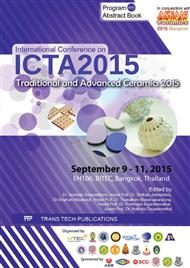p.224
p.230
p.236
p.240
p.246
p.252
p.259
p.264
p.268
Effect of SnCl4 Concentration on Transparent and Conducting Undoped Tin Oxide Thin Films
Abstract:
The purpose-built pyrolysis system based on an ultrasonically generated aerosol has been successfully used for deposition of highly transparent and conductive undoped tin (IV) oxide thin films. The morphological, structural, optical and electrical properties as well as electronic structures of the films for different concentrations of SnCl4.5H2O used as the starting precursor were investigated. FE-SEM displayed the substrate surfaces were uniformly covered with the film. The film thickness varied with the precursor concentration. XRD patterns showed the deposited films were a tetragonal phase and presented random orientations. The optical transmission spectra of all films revealed highly transmittance in the visible region. Refractive index of the films was between 1.85 and 2.0. XPS spectra for the Sn 3d5/2 and Sn 3d3/2 confirmed that the films were composed of SnO and SnO2 phases. The non-stoichiometric composition decreased with increasing concentration of the precursor. The films deposited with 0.30 M showed the highest conductivity and carrier concentration of 17 W-1cm-1 and 9.5 x 1019 cm-3, respectively. The disagreement of relation between XPS and Hall measurement suggested the higher carrier concentration arose from incorporation of residual chlorine from the solution precursor during deposition into the films. The interstitially incorporated chlorine considerably influenced the electrical properties of the films.
Info:
Periodical:
Pages:
246-251
Citation:
Online since:
May 2016
Keywords:
Price:
Сopyright:
© 2016 Trans Tech Publications Ltd. All Rights Reserved
Share:
Citation:


